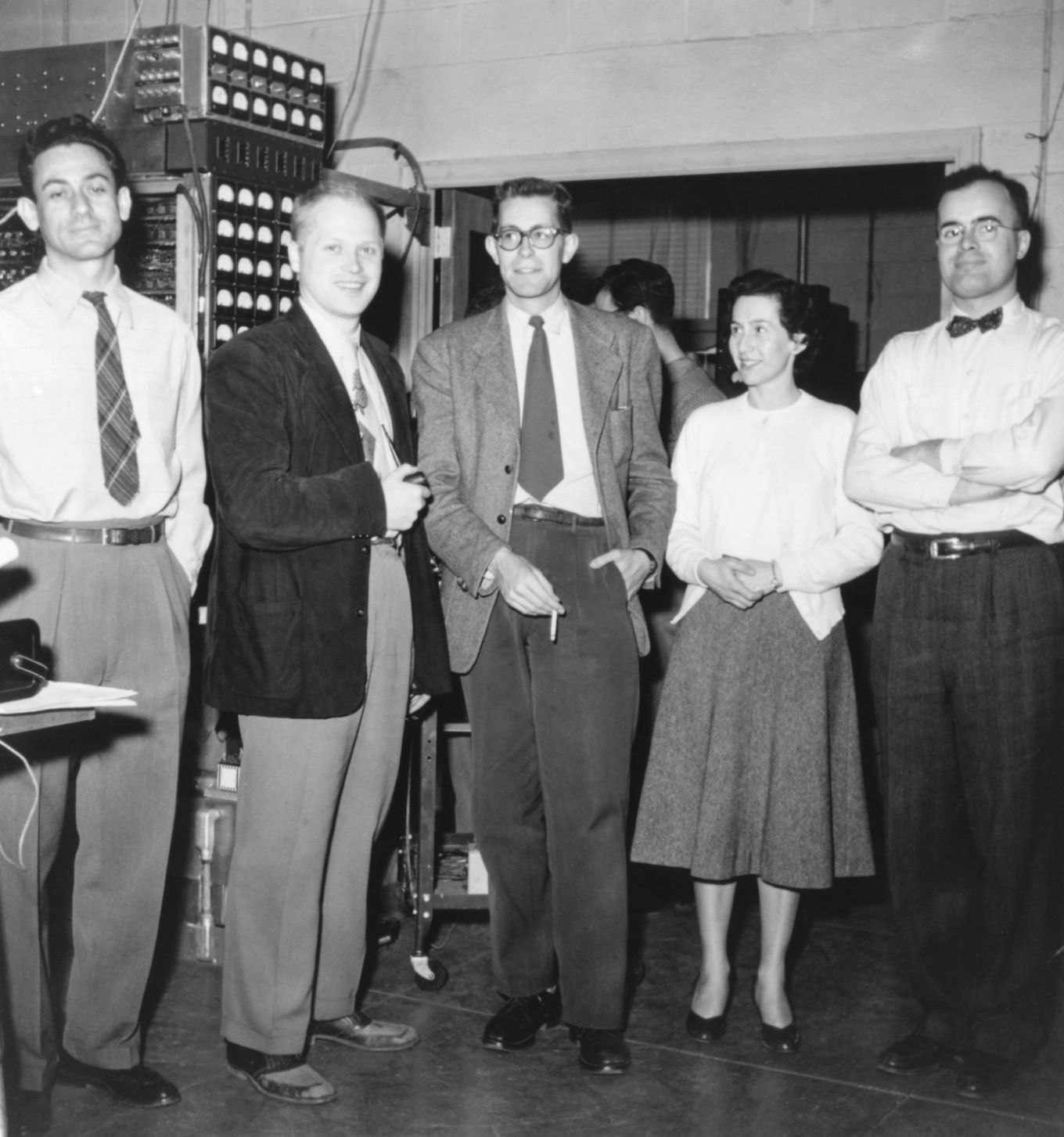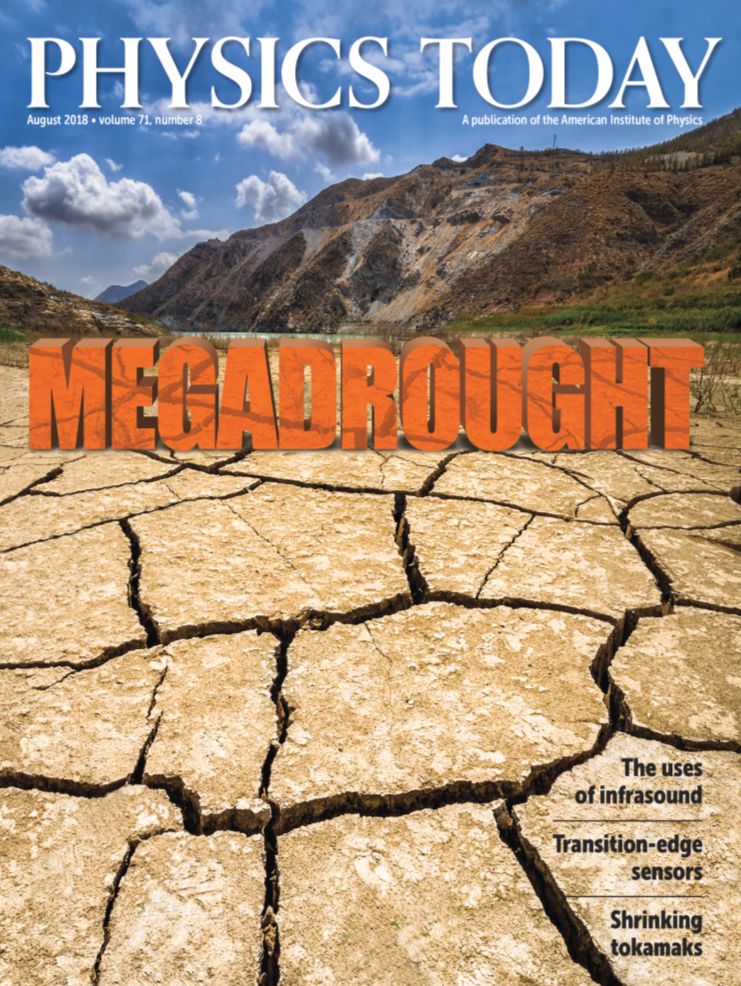Climate and weather in Physics Today
DOI: 10.1063/PT.3.4365
The American Meteorological Society was 29 years old when the first issue of Physics Today was published in May 1948. Then, as now, the magazine’s mission was to ensure that readers were kept informed about what was going on across the spectrum of physics and its related sciences regardless of their own specialties. At the turn of the past century, meteorology was largely a qualitative, observational science. But by 1919, when the AMS was founded, it was increasingly a quantitative, physical science. By 1948 the transformation was well underway.

Did Physics Today’s coverage of weather and climate recognize and reflect that transformation? As I discovered when I went through the magazine’s back issues, the answer is yes—but only partially and with some odd biases. What those biases were and what they might mean form the impetus of this article. But before I begin my exploration, I should say my use of “meteorology” embraces all the fields represented in the current portfolio of AMS journals. Physical oceanography qualifies, as do the economic effects of weather and climate on society.
Meteorology made a propitious debut in Physics Today with the publication in the fourth issue of “Down to the sea
Physical oceanography has been, until recently, the most unsuccessful of the geophysical sciences in enlisting the aid of physicists. Laboratory-trained, they have preferred to remain in their laboratories rather than set up their instruments in as unfavorable an environment as a small vessel. This has been exasperating to that small group of scientists having a burning desire to understand the physical aspects of the earth and its surrounding atmosphere.
In retrospect, Iselin’s feature represents a style of meteorological article that continues to appear in Physics Today. An author introduces a natural phenomenon, confidently presumes readers are interested in it, and then goes on to explain the underlying physics. Hans Panofsky’s feature article from December 1970, “Analyzing atmospheric behavior

Detail from Mesas in Shadow by Maynard Dixon, 1926. (Art Collection 3/Alamy Stock Photo.)

That consistency in features, however, was not matched by abundance of coverage for most of Physics Today’s history. No meteorological articles appeared in 1950–52, and just 13 did in 1953–69. The paucity of meteorology lasted until the 2000s, when articles and news stories about climate change began to frequent the magazine’s pages.
In December 2013 AMS joined the American Institute of Physics, and its members began to receive Physics Today as a result. In the 12 months before, and without regard to AMS joining the institute, the magazine published the feature articles “Water in the atmosphere
The upswing in meteorological coverage began in the mid 1990s and arose, in part, from the determination of my predecessor as editor-in-chief, Stephen Benka, to broaden the magazine’s editorial scope beyond condensed matter, particles, and other so-called mainstream physics. Accounting for the decades-long dearth is more challenging, because it entails figuring out why people didn’t do things.
Thirty years of fluid dynamics
The September 1978 issue of Physics Today included a feature article by Raymond Emrich and four coauthors to celebrate the 30th anniversary of the American Physical Society’s division of fluid dynamics
Interest in fluid dynamics as a separate field of physics with its own set of problems came about largely as a result of experiences during World War II. Until that time, the various events occurring in fluids were usually thought of as problems in mathematics or engineering.
The opening would have puzzled readers in Britain and France, where physicists have been doing research in fluid dynamics for more than a century. Joseph Boussinesq, Maurice Couette, Lewis Richardson, George Stokes, G. I. Taylor … (I could go on) were all born in the 19th century.
Despite the DFD’s efforts, the status of fluid dynamics in the US as a field of physics has been equivocal. Given that much of meteorology is applied fluid dynamics, it’s conceivable that meteorological coverage in Physics Today might have suffered from that uncertain status—not directly, perhaps, but as a consequence of the magazine’s stable of advisers not regarding fluid dynamics as physics.
Evidence of that bias is manifested in the pages of Physics Today in three ways. First, fluid dynamics has been covered even less frequently than meteorology. Second, the field itself has been underfunded in the US, presumably because of priorities set by physicists who advise and work for funding agencies. In 1986 a committee of the National Research Council published the 168-page report Physics through the 1990s: An Overview. The report was the focus of an April 1986 special issue of Physics Today. Fluid dynamics appeared in the article on plasmas and fluids
The third and most recent manifestation of bias was a column by the late Jerry Gollub
Earth is the oddball
The Search and Discovery department made its debut in Physics Today’s January 1967 issue. From then on, meteorological research papers were candidates for news coverage. The department’s first meteorological story reported observations of the atmosphere of Venus by two space probes, the Russian Venera 4 and the US Mariner 5. “Earth is the oddball
The story did not cite any publications or presentations, but subsequent meteorological stories did. Many of them covered research published in Science. If Science had an outsized influence on Physics Today, what sort of meteorology did the august journal publish?
Readers of Science from the late 1940s to the early 1960s received an oddly limited view of meteorology. In August 1948, for example, geologist William Herbert Hobbs contributed an article entitled “The climate of the Arctic as viewed by the explorer and the meteorologist.” Biologist Frits Went wrote in October 1950 about the effects of climate on plants. Veterinarian Glenn Van Ness wrote in November 1953 about the effect of climate on blue comb, a disease that afflicts young hens in summer.

Members of the Meteorology Project at the Institute for Advanced Study (IAS) in Princeton, New Jersey, in 1952. Left to right: Jule Charney, Norman Phillips, Glenn Lewis, Norma Gilbarg, and George Platzman. One of the earliest electronic computers, the IAS machine, is in the background. Project member Joseph Smagorinsky took the photo. (Courtesy of the AIP Emilio Segrè Visual Archives, gift of John M. Lewis.)

In the late 1950s and early 1960s, a new concern appeared in Science: modifying climate. Meteorologist Morris Neiburger contributed a long research article in October 1957 about the effects of smog on climate, notably in Los Angeles. Meteorologist Harry Wexler wrote in October 1958 about large-scale weather modification. When I encountered the two articles, I recalled that Walter Orr Roberts had written on climate modification
In the 1970s and 1980s, Science’s meteorological coverage increased. Most of it was about pollution, aerosols, planetary atmospheres, paleoclimate, and the effects on agriculture. Then, in the late 1980s, ozone depletion and climate change became more prominent in Science and its rival, Nature. Ozone, planetary atmospheres, and paleoclimate duly appeared in Physics Today’s news pages.
My own meteorological reporting followed that blinkered tendency to look only to Nature and Science. My first story reported on the tracking of 110 kg of a tracer, sulfur hexafluoride, that had been released in the South Atlantic Ocean at a depth of 4000 m (Physics Today, March 2000, page 18
What did we miss?
In her book Weather and Climate (2007), historian of science Kristine Harper provides a decade-by-decade survey of advances in meteorology. From the chapter on the 1940s, I learned of the University of Chicago’s Thunderstorm Project, the largest field campaign of its time. Five radar-equipped P-61 aircraft flew into thunderstorms over Ohio and Florida in 1946–47. Ground-based radar tracked balloons that had been released as tracers. From that data trove, the project’s scientists identified for the first time the three stages of thunderstorm formation.
The first stage, cumulus, occurs when daytime solar heating of the ground drives the formation of clouds in moist air. The storm enters the second, mature, stage when the cloud grows so large and heavy with water that rain falls while air continues to rise through the cloud. The two opposing flows, up and down, cause lightning to accompany what becomes heavy rain. In the third stage, dissipation, the updraft peters out, the rain becomes lighter, and the cloud disappears, starting from the bottom.
That momentous finding 1 did not make it into the pages of Physics Today. Others the magazine missed include Edwin Fisher’s 1956 finding that warm ocean water provides most of a hurricane’s energy, 2 Edward Lorenz’s 1963 discovery that weather depends so sensitively on initial conditions that forecasting beyond 10 days is impossible, 3 and Jacob Bjerknes’s proposal that the El Niño off the coast of Peru and the Southern Oscillation responsible for Asia’s monsoons are manifestations of the same interannual phenomenon. 4
Physics Today might be excused for overlooking individual papers, but the magazine pretty much failed to cover the early advances in numerical weather prediction. Joseph Smagorinsky was the founding director of the US Weather Bureau’s Geophysical Fluid Dynamics Laboratory. He was one of the originators of numerical weather prediction and its application to model Earth’s climate. His 1963 paper 5 “General circulation experiments with the primitive equations: I. The basic experiment” has been cited almost 7000 times. Regrettably, Smagorinsky’s name did not appear in Physics Today until this article.
A hint of an explanation for the magazine’s meteorological blind spots can be found in the career of another pioneering climate modeler, Jule Charney. He and Smagorinsky were among the meteorologists recruited by John von Neumann after World War II to work on numerical weather prediction at the Institute for Advanced Study in Princeton, New Jersey.
Von Neumann is best known to physicists for his work on quantum mechanics, game theory, and the theory of computation. He became and remained interested in numerical weather prediction because he had determined that it was feasible with the rudimentary computers of the time. Charney ran his computer model for the first time in 1950 and published his momentous conclusions a year later. 6
Charney favored publishing his research in meteorological journals. Of his 44 major publications, only five appeared in a journal, Proceedings of the National Academy of Sciences, whose editorial ambit extended beyond meteorology. The same preference is manifest in the meteorological milestones that I cite above: All were published in AMS journals. Past editors of Physics Today apparently did not seek research published in meteorological journals.
Climate change
How has Physics Today covered climate change? The first article to address changes to Earth’s climate was Roberts’s 1967 feature, “Climate control
Bergman, Hecht, and Schneider did not repeat that omission in their article “Climate models

Toby Ault and Scott St. George’s feature article about the decades-long droughts

Nine years later (February 1990) Physics Today’s Barbara Goss Levi reported on the status of climate change research. The title of her story, “Climate modelers struggle to understand global warming
In his November 1994 feature
One of the most significant articles that Physics Today published on climate change was “The discovery of the risk of global warming
By the 2000s Physics Today’s coverage of climate change implicitly acknowledged that it’s real and that it’s caused by anthropogenic carbon dioxide. In recent years, our news reporting and features have included more about the effects of climate change. For the magazine’s May 2016 issue, Physics Today’s David Kramer reported on how rising sea levels threaten the city of Norfolk, Virginia
Climate change will continue to appear in our pages, as will weather and all the other aspects of meteorology that AMS members, past and present, have done so much to elucidate.
References
1. H. R. Byers, R. R. Braham Jr, J. Meteorol. 5, 71 (1948).
2. E. L. Fisher, J. Meteorol. 15, 328 (1958).
3. E. N. Lorenz, J. Atmos. Sci. 20, 130 (1963).
4. J. Bjerknes, Mon. Weather Rev. 97, 163 (1969).
5. J. Smagorinsky, Mon. Weather Rev. 91, 99 (1963).
6. J. G. Charney, in Compendium of Meteorology, T. F. Malone, ed., American Meteorological Society (1951), p. 470.
More about the Authors
Charles Day is the editor-in-chief of Physics Today.

